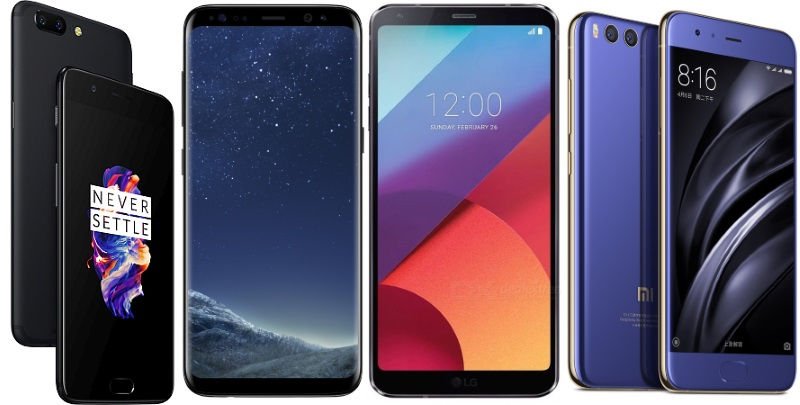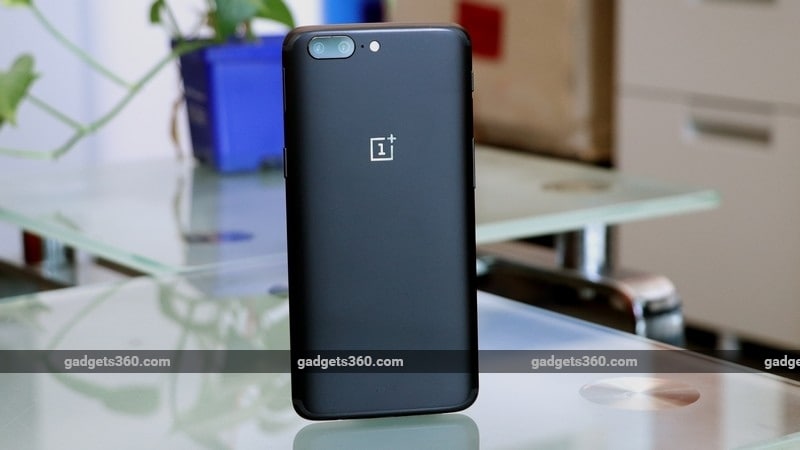
OnePlus 5 is the new flagship from a Chinese startup that has become a household name and seen its fan base growing ever since its first smartphone – the OnePlus One – hit the market. The new flagship was officially revealed on Tuesday, and it will going on sale later this month in several markets including India where it will go on sale from Thursday.
The OnePlus 5, much like its predecessor, packs some top notch specifications including the Qualcomm Snapdragon 835 SoC and up to 8GB of RAM. It also boasts of a new design approach, and the overall package appears to match several rival flagship smartphones. With its higher price tag, the OnePlus 5 will be pitted against some of the other popular premium smartphones.
To put it another way, the OnePlus 5 looks set to offer performance comparable to the Samsung Galaxy S8, LG G6, and Xiaomi Mi 6, with top notch specifications and a premium package. We compare the four smartphones.
Price
The OnePlus 5 will be going on sale in the US and select European regions at a starting price of $479 (roughly Rs. 31,000) and EUR 499 (roughly Rs. 35,900) respectively for the 6GB RAM and 64GB storage variant. The 8GB RAM and 128GB storage variant has been priced at $539 (approximately Rs. 35,000), and EUR 559 (about Rs. 40,000) in the US and the select European markets, respectively. The Chinese company is yet to announce the India pricing for the OnePlus 5 but we can expect our wait to be over on Thursday.
The Samsung Galaxy S8 was launched in India at Rs. 57,900 (MOP) for the 4GB RAM and 64GB storage model. The LG G6 price in India was announced at Rs. 51,990 (MOP) which made it significantly cheaper than the rival Galaxy S8.
Coming to the Xiaomi Mi 6 price, there are two variants at different price points. The Mi 6 variant with 64GB storage and 6GB RAM has been priced at CNY 2,499 (roughly Rs. 23,500), while the model with 128GB storage and 6GB RAM costs CNY 2,899 (roughly Rs. 27,000); both variants come in Black, White and Blue colour options. The company is yet to officially announce the smartphone in India.
Design
The Chinese company at the global unveiling talked about how the OnePlus 5 was cast out of the anodised aluminium and it does indeed look premium from all angles. We, however, have to confess that the OnePlus 5 indeed sports an iPhone 7 Plus-like design, especially the rear panel. The front is more or less mimics the predecessor, the OnePlus 3T, though the rear entirely looks inspired by the iPhone 7 Plus.

The Samsung Galaxy S8 (Review) and LG G6 (Review), on the other hand, bring an all-new design strategy with the display taking the centre stage. Both the phones were unveiled earlier this year with an 18.5:9 and 18:9 display aspect ratio respectively, instead of industry standard 16:9. Coming to the Xiaomi Mi 6 (First Impressions), it’s very similar to the Mi 5 in terms of shape and size. The Xiaomi flagship looks more refined and premium with four-sided curved glass on four sides, and a frame made of stainless steel. Considering the design is a very subjective matter, we feel that the buyer is the best judge.
Display
OnePlus 5 features a 5.5-inch full-HD (1080×1920 pixels) Optic AMOLED display which supports sRGB and DCI-P3 colour standards, and also sports 2.5D Gorilla Glass 5. The display on the OnePlus 5 brings many improvements over the OnePlus 3T. However, this might turn out to be the phone’s biggest weakness considering that it will be compared to the likes of the Samsung Galaxy S8 and LG G6, both of which have bigger screens with higher resolutions. It’s worth pointing it out that both the OnePlus 5 and Mi 6 cost much less than those smartphones.
The Samsung Galaxy S8 sports a 5.8-inch bezel-less ‘Infinity Display’ with 1440×2960 pixels screen resolution. The LG G6 features a 5.7-inch QHD+ (1440×2880 pixels) FullVision display.
The Xiaomi Mi 6 has been also claimed to bring improvements to its display panel which will feature reduced glare for eye care. The Mi 6 features a 5.15-inch full-HD (1080×1920 pixels) display which is smallest among the four. Its maximum brightness is 600 nits, but the brightness can be reduced automatically down to as low as 1 nit to reduce eye-strain.
Specifications
The OnePlus 5 has been launched running OxygenOS based on Android 7.1.1 Nougat and supports dual-SIM with dual-standby. It is powered by the latest Qualcomm Snapdragon 835 SoC clocked at four cores at 2.4GHz and other four cores at 1.9GHz. It will be available in 6GB with 64GB storage and 8GB RAM with 128GB storage options. The phone supports 4G LTE (with VoLTE), dual-band Wi-Fi 802.11 a/b/g/n/ac, Bluetooth v5.0, NFC, GPS/ A-GPS, and USB Type-C (v2.0). It weighs 153 grams, and measures 154.2×74.1×7.25mm.
Samsung Galaxy S8, in India, is powered by a Exynos 9985 chipset coupled with 4GB of RAM and 64GB inbuilt storage with up to 256GB storage expansion. It runs on Android 7.0-based company’s UX, and comes with a USB Type-C port. Samsung in select markets also launched the Galaxy S8 with Snapdragon 835 SoC (2.3GHz Quad + 1.7GHz Quad).
The Mi 6 packs the octa-core Qualcomm Snapdragon 835 SoC clocked at 2.45GHz coupled with 6GB of RAM and Adreno 540 GPU. The company has ditched the 3.5mm headphone jack, and the USB port is USB Type-C.
The LG G6 specifications include a Qualcomm Snapdragon 821 SoC with 4GB of LPDDR4 RAM. Out of the four smartphones compared, the LG G6 is the only that packs the older-generation Snapdragon 821 SoC. It has been launched in two storage options – 32GB and 64GB. The LG G6 will support expandable storage via microSD card (up to 2TB).
Cameras
OnePlus 5, LG G6, and Xiaomi Mi 6 are the phones that offer a dual camera setup at the back. The OnePlus 5 sports a 16-megapixel main camera (Sony IMX398 sensor, 1.12-micron pixels) with an f/1.7 aperture coupled with a 20-megapixel telephoto camera (Sony IMX350 sensor, 1-micron pixels) with an f/2.6 aperture. OnePlus is heavily marketing the fast autofocus, capability. The rear camera setup features a dual-LED flash module and boasts of 4K video recording with EIS. The dual cameras offer features like Bokeh effect and also deliver optical zoom up to 2x, and bumped up to 8x using a multi-frame software algorithm.
The Xiaomi Mi 6 sports dual 12-megapixel rear cameras, a setup reminiscent of the iPhone 7 Plus. The phone features a 12-megapixel wide-angle lens and another 12-megapixel telephoto camera for 2x lossless zoom. Its binocular stereoscopic vision imaging and depth learning algorithm makes edge recognition more accurate in the photos, says Xiaomi. The Mi 6 camera features phase-detection autofocus, and four-axis anti-shake functionality to ensure blur-free images.
As for the front camera, the OnePlus 5 sports a 16-megapixel front camera while the Mi 6 sports an 8-megapixel camera with 1080p video capture.
LG G6 sports a dual rear camera setup with two 13-megapixel sensors – one for wide-angle shots with 125-degree lens and f/2.4 aperture, and the other for regular shots with 71-degree lens and OIS 2.0. At the front, the smartphone sports a 5-megapixel wide-angle lens with f/2.2 aperture and 100-degree lens.
The Samsung Galaxy S8 sports a 12-megapixel ‘Dual Pixel’ rear camera with optical image stabilisation and an f/1.7 aperture. It also offers an 8-megapixel front camera.
Of course, the sensor resolution and lens aperture are not enough to determine photo quality. You will have to wait for our full review of the Xiaomi Mi 6 and OnePlus 5 after which we can give a verdict whether they offer better image quality than the LG G6 and Samsung Galaxy S8 (Review).
Let us know whether you are excited about the new OnePlus 5 via the comments section. Do you feel that the OnePlus 5 can compete against the Samsung Galaxy S8, LG G6, and Xiaomi Mi 6 in performance? Do let us know.


 HIGHLIGHTS
HIGHLIGHTS


